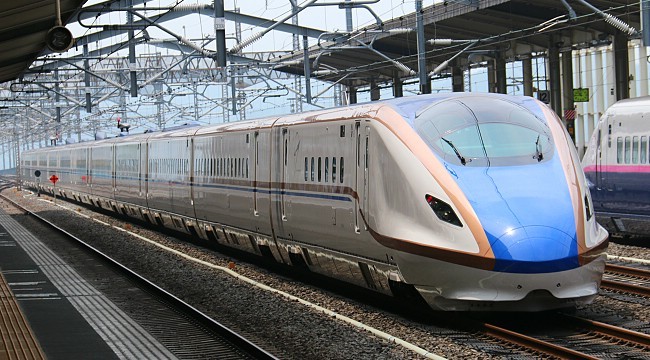Hokuriku Shinkansen Extension

On March 14, 2015, the Hokuriku Shinkansen, currently popularly known as Nagano Shinkansen, will be extended from Nagano to Kanazawa, dramatically cutting travel times between Tokyo, Toyama and Kanazawa.
The extended shinkansen line will make the beautiful Hokuriku Region more easily accessible, change travel patterns and open new possibilities of exploring the country. The Hokuriku Region along the Sea of Japan coast is rich in tradition and offers pleasant countryside and spectacular natural scenery. Among the less obvious destinations to profit from easier access from Tokyo will be Shirakawago.
Train categories, stopping patterns and seating
Currently served by just a single train category, the Hokuriku Shinkansen will see three additional train categories once the line is extended to Kanazawa on March 14, 2015:

The Kagayaki will be the fastest train category along the Hokuriku Shinkansen, departing Tokyo and Kanazawa in the mornings and evenings. On its 2.5 hour journey between Tokyo and Kanazawa, it will stop only at Ueno, Omiya, Nagano and Toyama. The Kagayaki features twelve cars, one of which is Gran Class, the first class service by JR. The Kagayaki will be one of the few shinkansen trains without non-reserved seating. A seat reservation will be mandatory. When all seats are booked out, standing tickets can be purchased.

The Hakutaka is the slower of the two train categories that run along the entire length of the Hokuriku Shinkansen. It skips many stations between Tokyo and Nagano, but stops at most of the stations beyond Nagano. The Hakutaka features the same train sets as the Kagayaki, but it does offer non-reserved seating. It requires 20 to 50 minutes longer than the Kagayaki to make the trip between Tokyo and Kanazawa.

The Asama will continue running just between Tokyo and Nagano, using 8-car train sets without Gran Class.

The Tsurugi will shuttle between Kanazawa and Toyama Station, catering to local traffic between the two cities and providing travelers arriving by limited express train from Osaka and Kyoto with a connection to Toyama. Cars 8, 9, 10 and 12 of Tsurugi trains will not be useable.


Note: For simplification, some rare train compositions and stopping patterns are omitted.
Impact on rail passes
The Japan Rail Pass will be valid on all trains along the Hokuriku Shinkansen!
However, with the opening of the shinkansen extension to Kanazawa, the regular JR lines between Nagano and Kanazawa (colored green on the map below) will newly be operated by four prefectural non-JR railway companies. As a result, the Japan Rail Pass will not be valid on these railway sections anymore. There will be two exceptions to keep isolated JR lines accessible to pass holders, though:
- Pass holders may use non-JR trains between Kanazawa and Tsubata (but are not allowed to get on or off anywhere in between) in order to access the JR Nanao Line which connects Tsubata with Wakura Onsen on the Noto Peninsula.
- Pass holders may use non-JR trains between Takaoka and Toyama (but are not allowed to get on or off anywhere in between) to access the JR Himi Line and the JR Johana Line
The above rules will also apply to the Seishun 18 Kippu.
The JR East Pass will be valid on all train types along the Hokuriku Shinkansen between Tokyo and Joetsu Myoko Station, but not beyond Joetsu Myoko Station.
The JR Kansai Hokuriku Area Pass will be valid on the Hokuriku Shinkansen between Kanazawa and Joetsu Myoko, while the JR Hokuriku Area Pass will be valid between Kanazawa and Kurobe Unazuki Onsen Station. Both passes cover only non-reserved seats, meaning that they are not valid on the all-reserved Kagayaki trains.

Changing Travel Patterns
The extended shinkansen line will cut travel time from Tokyo into the Hokuriku Region dramatically. Below are some of the prominent destinations that will profit from access improvements:

|
|

|
|

|
|

|
|

|
|

|
|

|
|

|
|
New travel routes
The extended Hokuriku Shinkansen will create an alternative to the Tokaido Shinkansen for fast travel between Eastern Japan (Tokyo) and Western Japan (Kyoto/Osaka). It will be particularly attractive for those interested in seeing Kanazawa or in balancing their city sightseeing with a visit to Japan's countryside and nature that can be found abundantly in the Hokuriku Region. Possible travel routes could include the following:



